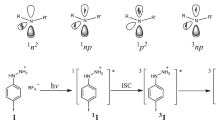Abstract
The singlet molecular oxygen-oxidation of tryptophan generates diastereoisomeric dioxindolylalanine (diOia) along with hydroperoxides, alcohols and carbonyl compounds. Mechanistic investigations based on isotopic labeling and MS/MS analyses support diOia formation through a dioxetane intermediate.
Similar content being viewed by others
Notes and references
§ diOia are diastereomeric α-amino-2,3-dihydro-3-hydroxy-2-oxo-1H-indole-3-propanoic acids. Diastereoisomerism is possible because of a second asymmetric center, the indoline C3 atom. The more polar isomer (fast elution in a C18 column) was identified as R,S diOia and the stereochemistry was deduced by a comparison with trans 2-carboxy-3a-hydroperoxy-1,2,3,3a,8,8a-hexahydropyrrolo[2,3-b]indole (in this isomer, the hydroperoxy group has a trans configuration in relation to the carboxylic acid group, see ref. 2). The assignment was possible since R,S diOia is detected in trans WOOH samples submitted to long term storage. Similarly, R,R diOia was identified as the less polar isomer, with its stereochemistry being obtained from that of the cis WOOH isomer.
¶ Studying the mechanism of pyrrole photooxygenation, it was found that the reaction with water is a preferred mechanism only when water is also the solvent (see ref. 11). However, for the case of pyrroles, a putative dioxetane arises from an endoperoxide rearrangement, so whether water is involved in the nucleophilic decomposition of an endoperoxide or its rearranged dioxetane is unknown.
This is an effect also observed for the cis-hydroperoxide isomer, which is less stable than trans-WOOH.
M. Nakagawa, H. Watanabe, S. Kodato, H. Okajima, T. Hino, J. L. Flippen and B. Witkop, A valid model for the mechanism of oxidation of tryptophan to formylkynurenine—25 years later, Proc. Natl. Acad. Sci. U. S. A., 1977, 74, 4730–4733.
G. E. Ronsein, M. C. B. Oliveira, S. Miyamoto, M. H. G. Medeiros and P. Di Mascio, Tryptophan oxidation by singlet molecular oxygen [O21Δg)]: mechanistic studies using 18O-labeled hydroperoxides, mass spectrometry, and light emission measurements, Chem. Res. Toxicol., 2008, 21, 1271–1283.
S. Gurnani, M. Arifuddin and K. T. Augusti, Effect of visible light on amino acids—I. Tryptophan, Photochem. Photobiol, 1966, 5, 495–505.
I. Saito, T. Matsuura, M. Nakagawa and T. Hino, Peroxidic intermediates in photosensitized oxygenation of tryptophan derivatives, Acc. Chem. Res., 1977, 10, 346–352.
M. Gracanin, C. L. Hawkins, D. I. Pattison and M. J. Davies, Singlet-oxygen-mediated amino acid and protein oxidation: formation of tryptophan peroxides and decomposition products, Free Radical Biol. Med., 2009, 47, 92–102.
A. M. Bond, D. J. Tucker, Z. Qing and D. E. Rivett, Determination of the redox active forms of oxindolylalanine and peptides of kynurenine on the basis of electrochemical studies at mercury electrodes in aqueous media, J. Electroanal. Chem., 1991, 315, 125–141.
H. Hock and O. Schrader, Der mechanismus der autoxydation einfacher kohlenwasserstoffe als beitrag zur autoxydation von brennstof-fen, Angew. Chem., Int. Ed., 1936, 49, 565–566.
H. Takeshita and T. Hatsui, Sensitized photoreduction of dioxetanes to cis-1,2-glycols: solvent and sensitizer dependencies on the singlet oxygen oxidation, J. Org. Chem., 1978, 43, 3080–3083.
C. Pierlot, J. Aubry, K. Briviba, H. Sies and P. Di Mascio, Naphthalene endoperoxides as generators of singlet oxygen in biological media, Methods Enzymol, 2000, 319, 3–20.
W. H. Fenical, D. R. Kearns and P. Radlick, Mechanism of the addition of 1Δg-excited oxygen to olefins. Evidence for a 1,2-dioxetane intermediate, J. Am. Chem. Soc, 1969, 91, 3396–3398.
D. A. Lightner, G S. Bisacchi and R. D. Norris, On the mechanism of the sensitized photooxygenation of pyrroles, J. Am. Chem. Soc, 1976, 98, 802–807.
W. Adam and M. Heil, Reaction of 1,2-dioxetanes with heteroatom nucleophiles: adduct formation by nucleophilic attack at the peroxide bond, J. Am. Chem. Soc, 1992, 114, 5591–5598.
G E. Ronsein, M. C. B. Oliveira, M. H. G Medeiros and P. Di Mascio, Characterization of O2(1Δg)-derived oxidation products of tryptophan: a combination of tandem mass spectrometry analyses and isotopic labeling studies, J. Am. Soc. Mass Spectrom., 2009, 20, 188–197.
A. A. Frimer, The reaction of singlet oxygen with olefins: the question of mechanism, Chem. Rev., 1979, 79, 359–387.
H. H. Wasserman and S. Terao, Enamine singlet oxygen reactions— alpha-diketones from intermediate amino dioxetanes, Tetrahedron Lett., 1975, 16, 1735–1738.
N. Kornblum and H. E. DeLaMare, The base catalyzed decomposition of a dialkyl peroxide, J. Am. Chem. Soc., 1951, 73, 880–881.
W. Ando, J. Suzuki, T. Arai and T. Migita, Singlet oxygen reaction. 2. Alkylthiosubstituted ethylene, Tetrahedron, 1973, 29, 1507–1513.
W. Ando, T. Saiki and T. Migita, Singlet oxygen reaction. 4. Pho-tooxygenation of enamines involving a 2-step cleavage of 1,2-dioxetane intermediate, J. Am. Chem. Soc., 1975, 97, 5028–5029.
W. Baader, C. Stevani, and E. Bastos, Chemiluminescence of organic peroxides, in The Chemistry of Peroxides, ed. Z. Rappoport, John Wiley & Sons Ltd, New York, 2006, pp. 1211–1278.
W. H. Richardson, G. Batinica, K. Janota-Perret, T. Miller and D. Shen, Excited state selectivity in the thermolysis of a 3,4-diaryl-3,4-dimethyl-1,2-dioxetane, J. Org. Chem., 1991, 56, 6140–6144.
I. Saito, M. Imuta and T. Matsuura, Photoinduced reactions. LXV. Photosensitized oxygenation of 2-methylindoles, Chem. Lett., 1972, 1173–1176.
X. J. Zhang, C. S. Foote and S. I. Khan, Reactions of N-acylated indoles with singlet oxygen, J. Org. Chem., 1993, 58, 47–51.
D. A. Lightner and C.-S. Pak, Dye-sensitized photooxygenation of tert-butylpyrroles, J. Org. Chem., 1975, 40, 2724–2728.
Author information
Authors and Affiliations
Corresponding author
Additional information
In memoriam of Prof. Giuseppe Cilento.
Electronic supplementary information (ESI) available: Detailed materials and methods description, and 1H NMR, 13C NMR and accurate mass spectral measurements. See DOI: 10.1039/c1pp05181d
Rights and permissions
About this article
Cite this article
Ronsein, G.E., Bof de Oliveira, M.C., Gennari de Medeiros, M.H. et al. Mechanism of dioxindolylalanine formation by singlet molecular oxygen-mediated oxidation of tryptophan residues. Photochem Photobiol Sci 10, 1727–1730 (2011). https://doi.org/10.1039/c1pp05181d
Received:
Accepted:
Published:
Issue Date:
DOI: https://doi.org/10.1039/c1pp05181d




